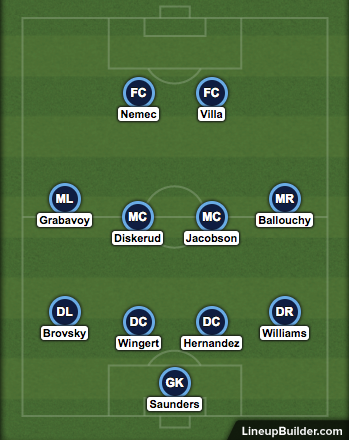After a slow-burning offseason, Minnesota United’s roster looks nearly ready for the club’s MLS debut on March 3. Enough pieces are in place to begin guessing at an opening day roster, but will the roster be the same come July? In this piece, we look at how previous expansion clubs have evolved during their inaugural seasons to get a sense of just how much Minnesota’s might change.
With the addition of midfielder Bashkim Kadrii, goalkeeper John Alvbåge, and midfielder Kevin Molino, Loons fans can now piece together a comfortable starting lineup for the squad’s March 3 season opener in Portland. In his piece discussing the team’s depth, Jeff Rueter proposed the following opening day depth chart.

Even if this is the lineup for the season opener, it’s unlikely to be the same when the regular season ends in October. As the season goes on, the club will run into depth issues (looking at you, full backs) and find some areas that need to be filled with some signings in the summer transfer window. Let’s look back to how the inaugural Orlando City SC and New York City FC rosters changed throughout year one.
(Note: The 2017 MLS Transfer Windows are Feb. 14 – May 8 and July 10 – Aug. 9)
Orlando City SC
When the two expansion clubs faced off on opening day in 2015, then-Lions’ head coach Adrian Heath deployed a 4-2-3-1 with aged Expansion Draft selection Donovan Ricketts in goal. It’s worth noting that eventual Rookie of the Year Cyle Larin wasn’t in the opening-day lineup for Orlando.

While the club didn’t make any major changes to the roster, by the end of the season Orlando brought in five players and either loaned or released eight.
Ricketts appeared in only 10 matches for the Lions before being benched in favor of Tally Hall, who started most of the club’s remaining matches. In July, Orlando traded Ricketts to the LA Galaxy for a second round SuperDraft selection. Amobi Okugo was the second player who started opening day to be traded, going to Sporting KC in exchange for midfielder Servando Carrasco.
The club brought in three other players in the July transfer window, midfielder Adrian Winter, center back David Mateos, and forward Adam Bedell, but only Winter saw any substantial playing time over the second half of the season.
Most of the club’s movement came from loans, which didn’t occur until May. The club decided to loan out forward Sidney Rivera, keeper Josh Ford, defensive midfielder Conor Donovan, and center back Tommy Redding. Three of those players (Rivera, Donovan, and Redding) were recalled from their loans not long after.
Meanwhile, the club’s two loanees, Seb Hines and Martin Paterson, ended their loans in August. Hines was signed by the club after his contract ran out with Middlesbrough and continued to start for much of the rest of the season.

The last 2015 lineup for the club saw formerly loaned-out keeper Ford now starting, as well as the young phenom Larin, who wasn’t even on the bench on opening day. Mid-season acquisition Winter also made a start.
All-in-all, Orlando didn’t make any major moves in the club’s first MLS season. The rise of Larin and the foreseeable struggles of a 37-year-old keeper caused the biggest shifts in the Lions’ lineups.
Different starters on the final day compared to opening day: five
New York City FC
NYCFC took a very different approach. The club deployed a traditional 4-4-2 formation on day one, with their marquee signing David Villa up top. Former Loon Jeb(!) Brovsky started on opening day for his second expansion club.

In the July, the club brought in three aged, international players: regista Andrea Pirlo, midfielder Frank Lampard, and right back Andoni Iraola. However, the trio combined for only 29 starts in the second half of the season. The club also didn’t loan out any players during the 2015 season.
In stark contrast to the Lions, NYCFC had a stable goalkeeping situation, with Josh Saunders starting all but one game in the club’s first two years.

As with Orlando, by the time the club arrived at opening day, its first round SuperDraft pick (Khiry Shelton) had made it into the club’s starting lineup. The club had also transitioned in a 4-2-3-1 to better suit its playmakers and try to maximize the talent on the pitch.
Different starters on the final day compared to opening day: six
What does this mean for Minnesota United?
On Thursday, we saw the club’s first preseason lineup with all announced signings present and acclimated, giving fans an idea of what they might see on March 3 when the regular season kicks off in Portland. Though he struggled at times in his start, it seems likely that Minnesota’s first round SuperDraft pick Abu Danladi will find his way on to the pitch sooner rather than later.
The Loons’ current roster-building strategy more closely resembles Orlando than NYCFC. Fans can expect more loaning out of young players instead of big, midseason signings. Still, the club needs to figure out their goalkeeping situation once the Alvbåge loan is over in July and likely needs to find more depth (or starters) at full back, and a second outright defensive midfielder to provide cover for Collen Warner. A lot will almost certainly change over the course of the season. We’ll see what gems the club can unearth once July rolls around.
FiftyFive.One is now on Patreon. Do you like the independent coverage of soccer news from Minnesota and beyond that FiftyFive.One offers? Please consider becoming a patron.

Leave a Reply